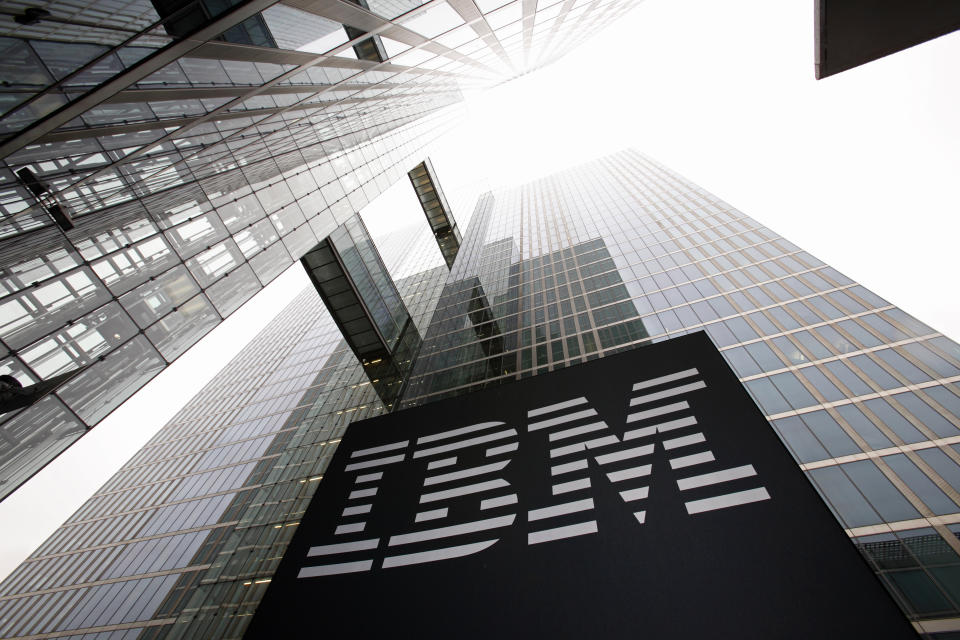IBM Served Up Some Surprises in Q1
Computing powerhouse IBM (NYSE: IBM) reported first-quarter results this Tuesday. The company is switching gears in many ways, from a new set of business segments to a different view of what's driving the company forward. Here's a closer look at Big Blue's latest report.
IBM's fourth-quarter results: The raw numbers
Metric | Q1 2019 | Q1 2018 | Year-Over-Year Change |
|---|---|---|---|
Revenue | $18.2 billion | $19.1 billion | (4.7%) |
Net Income | $1.59 billion | $1.68 billion | (5.4%) |
GAAP earnings per share (diluted) | $1.78 | $1.81 | (1.7%) |
Data source: IBM. GAAP = generally accepted accounting principles.
What happened with IBM this quarter?
Compared to the year-ago period, external revenues fell in three of IBM's five reportable segments. Global business services (GBS) and global financing were the exceptions to the rule, holding external sales steady at $4.12 billion and $406 billion, respectively. Cloud and cognitive software saw revenue fall 1.5%, to $5.04 billion, while global technology services stopped at $6.88 billion -- 7.4% below the previous year's first quarter. Systems sales plunged 11% lower due to the cyclical downturn in mainframe sales continuing as expected.
Operating margins trended generally upward. IBM's cloud products led the way among non-finance operations, rising from 28% to 30%. Business services more than doubled its pre-tax margins from 3% to 7.5%. Technology services quadrupled its profit margin to 4%.
Big Blue chose to stop reporting separate growth results for its so-called strategic imperatives at this time. Management said that this metric has run its course now that these higher-growth businesses account for more than half of IBM's total revenues. The most important focus areas at this point include cloud computing, operating leverage, and stronger margins across the board.
Earnings per share didn't fall as dramatically as the underlying net income line, all thanks to a generous share-buyback program that reduced IBM's diluted share count by 3.4% year over year at a total cost of $4.7 billion.

Image source: Getty Images.
What management had to say
On the earnings call, CFO Jim Kavanaugh explained how the company is reorganizing in preparation for the buyout of open-source veteran Red Hat (NYSE: RHT). According to Kavanaugh:
First, we brought our cloud and cognitive software together in one segment. Second, we combined our security services with security software, consistent with the way we are running that integrated business. And then finally, we moved the results for the businesses we're divesting to the "other" category, to provide better transparency to the ongoing operational performance of our software and GBS segments.
The company is currently educating its entire workforce on how cloud computing serves as the foundation of IBM's future plans, built around Red Hat's incoming tools and platforms. This buyout should be a game changer, and Kavanaugh argues that the combination is "accelerating the leadership in a $1 trillion hybrid cloud market."
Looking ahead
The Red Hat deal should close in the second half of 2019, but the exact timing of that event will depend on regulatory approvals. The acquisition should boost IBM's revenues by roughly 4% and grow free cash flow by approximately 9% when it happens, which is a material impact on the combined company's finances. Therefore, IBM's full-year guidance updates simply don't include any expected Red Hat contributions.
All that being said, Big Blue held its full-year guidance steady, with projected GAAP earnings of at least $12.45 per diluted share. Expectations for free cash flow were also unchanged, adding up to roughly $12 billion. This compares to GAAP earnings of $9.51 per share in 2018, alongside free cash flow of $11.9 billion.
More From The Motley Fool
Anders Bylund owns shares of IBM and Red Hat. The Motley Fool is short shares of IBM. The Motley Fool has a disclosure policy.

 Yahoo Finance
Yahoo Finance 